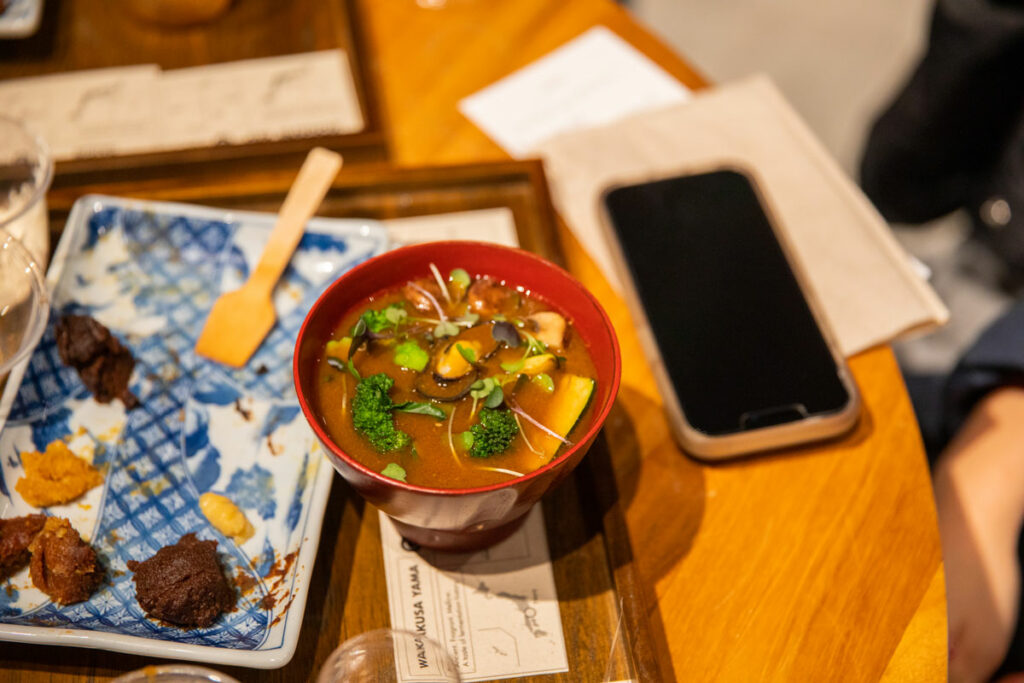When miso first hit the US shores back in the 80s, it was primarily associated with sushi. Americans first met the 1300-year-old Japanese tradition of fermented soybean-salt-koji culture (and sometimes grains) in the complementary bowls of miso soup that accompanied their Sushi Deluxes. This was a pretty sad introduction to one of Japan’s oldest and most treasured artisanal foods.
Nowadays, American cooks are more familiar with miso, and may even—if pressed—be able to identify white, red, or dark varieties. While that’s better than it used to be, it’s still only as exact as being able to tell the difference between white, rosé, or red wines. In Japan, miso comes in distinct regional styles that yield a vast spectrum of color and taste variations. Beyond the shared notes of salt and umami, Japan’s regional miso styles range from sweet, mild, and nutty to salty, intense, and exploding with umami. If there could be a Western analog, the artisanal miso styles of Japan offer the regional diversity of winemaking in France. Happily for Americans, an increasingly wide variety of imported Japanese misos are available in specialty markets. In New York, The Rice Factory and Dashi Okume are excellent sources of imported misos and both have online markets.

In recent years, the Japanese government, including the Consulate General of Japan in New York and JETRO New York, has been making efforts to raise American awareness of imported Japanese misos. At events hosted by these entities, Japanese miso experts conduct tastings and present education programs designed to showcase miso’s versatility, health benefits and wide diversity of styles and varieties. These events clear up a lot of confusion.
For instance, it’s a common American misconception that miso has limited use outside of traditional Japanese foods. Sure, we’ve all seen miso soup and miso-ginger salad dressing, but we don’t regularly find ourselves reaching for miso while cooking dinner. This is a missed opportunity. A recent miso tasting event at Dashi Okume hosted by the Consulate General of Japan was guided by Japanese miso expert, Mr. Masaaki Sano. He’s the third-generation owner of the famed miso specialty store in Tokyo, Sano Miso. According to Mr. Sano, the salt and umami of miso enhances nearly everything it meets—meat, fish, dairy, even beverages—plus, it’s easy to keep on hand. When frozen, miso remains scoopable—you can spoon out a dollop of miso whenever you want to add depth to a dish (frozen, miso lasts up to a year). On steaks, the umami of dark miso mimics the intensity of aged beef while its natural sugars amp up the Maillard reaction—the caramelization that lends flavor to seared foods. On seafood, white misos add a subtly more complex and nuttier version of salt. In vegetables, miso is a flavor enhancer—it makes everything taste more and better.

Consider the things that we commonly use to bump up salt and add umami to our cooking—Parmigiano Reggiano, anchovies, capers, olives, Worcestershire sauce, tomato paste, aged cheeses, nutritional yeast, soy and fish sauces. In cooking, miso belongs in that family of products—but, because Japanese misos are available in such variety, miso offers a huge spectrum of expressions. This has not escaped the notice of many American chefs, including Momofuku’s David Chang; he has become a staunch advocate of imported Japanese misos. As early as the mid-Oughts, Chang was serving roasted vegetables tossed in a simple 2:1 ratio of butter to miso. As Mark Bittman noted in The New York Times, Chang’s compound butter works on all sorts of dishes, “Melted onto fish, chicken or steak (lots of umami); on asparagus, broccoli or carrots; drizzled on a baked sweet potato (or a regular baked potato).”
It makes sense that miso, if reduced to its two most elemental characteristics (umami and salt), has been making appearances outside the confines of dinner. Take this article that suggests slicking some miso onto your morning buttered toast; the result is a far more delicious version of Marmite. Plus, miso is actually good for you: it’s rich in probiotics, B vitamins, amino acids, vitamin K, manganese, zinc, calcium—and, because it’s made from soy—protein. While you’re at it, you might as well whisk some miso into your scrambled eggs.

Given the last decade’s explosion of salted sweet foods, it was only a matter of time before the salt+ qualities of miso started creeping into desserts. Take Christina Tosi’s recipe for a Miso Butterscotch Sundae in which she roasts shiro (white) miso until its toasty flavors are amplified, then incorporates it in a sophisticated butterscotch sauce with brown sugar, butter, mirin, and vinegar. Or this recipe for Miso Caramel Sauce where the savory umami of miso improves on salted caramel. And you must’ve seen brownies garnished with sea salt, but check out Meera Sodha’s famed Salted Miso Brownies that are ooey, gooey and (amazingly) vegan. Basically, if you can think of a sweet that might be enhanced with a bit of salt, miso will make it better.
So, the next time you reach for just salt (or any of your usual umami-rich suspects), consider giving miso a whirl.

Miso-Herb Marinated Chicken
INGREDIENTS
1 Chicken Breast
Miso Paste:
2.5 oz of White Miso
1 oz Dark Red Miso
0.5 oz Cooking Sake
0.5 oz Mirin
1 tsp Dried Basil
1 tsp of your favorite dried herb (oregano, parsley, thyme etc)
INSTRUCTIONS
- Remove the bones from the chicken breast. Clean as needed.
- Mix all the ingredients for the miso paste.
- Apply the paste on both sides of the chicken evenly
- Let it rest in the refrigerator for 3 to 8 days (you can freeze it too)
- Remove the paste from the chicken. Save the removed paste.
- Using a pan, cook the chicken on low to medium heat, 6 minutes on each side. Be careful not to burn the chicken, as the marinade paste makes it easy to burn.
- Remove the chicken. Plate.
- Add the removed miso paste to the pan and heat up the paste
- Apply the miso paste on the chicken.
- ENJOY!

Consulate General of Japan in New York




